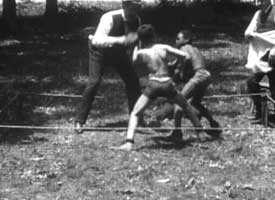 A Scrap in Black & White (1902) is a black vs white boxing match, in the form of a "scrap" between boys. The black kid gets the first knock-down. A referee & two trainers are all white. At the end of the match, the trainers throw a bucket of water on the lads.
A Scrap in Black & White (1902) is a black vs white boxing match, in the form of a "scrap" between boys. The black kid gets the first knock-down. A referee & two trainers are all white. At the end of the match, the trainers throw a bucket of water on the lads.
It seems to be a film void of racism, despite the loaded subject of white & black battle. There's absolutely no sense of this match having any greater meaning than kids exercising & playing.
It was an era where boys of differing races did frequently become friends. Yet at some point in their young lives their wildly differing stations in life would become known, & honored, & friends of childhood did not remain companionable when grown.
Many a deeply racist s.o.b. would take offense to such assessment of his character since his best friend when he was a child had been black, the ultimate "some of my best friends are" canard.
The cultural tragedy was that white kids could have black nannies & black playmates, & still grow up eager to embrace white privilege at great cost of rights & dignities for another race. But at least the weight of racism was not too soon visited upon children, perhaps the only time in life someone black could punch someone white in the face & not risk being killed by a pack of snaggletoothed rednecks.
For early films more typical of the treatment of African Americans, see reviews with The Watermelon Patch (1905). But for the first great black performer given a wonderful & praiseworthy role, see Laughing Gas (1907). And also see Kinetoscopic boxing films.
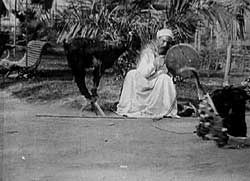 Alfred C. Abadie journeyed to the Far East making films for the Edison company.
Alfred C. Abadie journeyed to the Far East making films for the Edison company.
An extensive itinerary took him from Nice to Syria to Jerusalem to Egypt to Switzerland to Paris to England & back to the United States.
Thirty-four of his on-locations short films from this sweep of the world are known, including Egyptian Fakir & Dancing Monkey (1903), one of the more amusing oddities captured on celluloid.
The street-performing fakir beats a hand drum while a goat stands pertly on a tiny tripod. The fakir's trained monkey, wearing a suit of clothes, stands on its head & uses its prehensile tail to play with a wooden staff. Lastly the fakir & monkey duel with sticks.
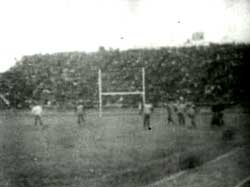 The roots of sports documentary can be found in Alfred Abadie's Princeton & Yale Football Game (1903).
The roots of sports documentary can be found in Alfred Abadie's Princeton & Yale Football Game (1903).
At this early date, an event covering a large area of movement presented special obstacles to filming, as heavy equipment did not pivot & refocus with ease & speed. Thus even with slow panning capacity, action frequently crosses the screen & the players leave the frame.
To capture broad moments of game action, Abadie moved the camera from place to place around a stadium, splicing the bits into a whole, condensing a game into a minute.
The numerous short scenes include shots of stadium attendees, game preliminariesk, a line drive, & a neatly framed pile-up.
There's not enough of a continuity of action to really enjoy it for the sake of game play, & the most impressive thing about it is the enormity of the crowd in attendance.
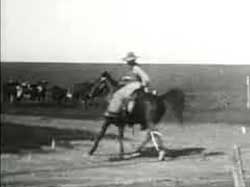 Driving Cattle to Pasture (1904) is a western scene, a great deal of action packed into under a minute.
Driving Cattle to Pasture (1904) is a western scene, a great deal of action packed into under a minute.
A cowboy on horseback gets his horse to bucking. Cattle are hurrying down a trail toward pasture, a calf hopping & skippin at the front of the herd, cowboys on horseback forcing the cattle onward.
A. C. Abadie had gone to Bliss, in Oklahoma Territory, to film authentic scenes of cowboys & Indians at their daily occupations.
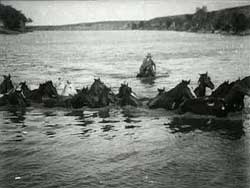 Abadie filmed several other documentary pieces in Oklahoma, including Herding Horses Across a River (1904). Abadie filmed several other documentary pieces in Oklahoma, including Herding Horses Across a River (1904).
This little film begins with a distant shot of men & horses on the far bank of a river. Quite a few horses are rapidly driven across the river by five cowboys on horseback, all swimming toward the camera on the nearer bank.
These films were inspired by the wild west shows that had been so popular in New York, including William Cody's famous show, which had brought interest in the subject of the west to a high pitch.
From the commercial angle it was also hoped that these films could coattail the continuing popularity of Edwin S. Porter's The Great Grain Robbery (1903), in which Alfred Abadie has a role as lawman.
The level of success for these wild west documentaries was not as great as expected, though they are credited with furthering the development of the western..
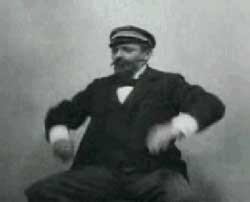 In a delightful short film of only about forty or forty-five seconds, a comedian sits in close-up in the very funny Transformation by Hats, Comic View (Chapeaux a transformations, 1895), an early pioneering film from the Lumiere brothers.
In a delightful short film of only about forty or forty-five seconds, a comedian sits in close-up in the very funny Transformation by Hats, Comic View (Chapeaux a transformations, 1895), an early pioneering film from the Lumiere brothers.
The music hall comic is Felcien Trewey, a friend of the Lumieres. He is also to be seen in A Game of Cards (Partie d'ecarte, 1895) with Antoine Lumiere, & in The Photograph (Photographe, 1895) with Auguste Lumiere.
Although Edison's Black Maria Studio in America filmed many burlesque acts, the Lumieres filmed rather few, making Transformation by Hats a bit different from the Lumiere's norm, & very likely Trewey's own idea, showing his various stage personas in rapid succcession. No trick photography was required; the comedian really is that quick at transformation.
Trewey bends over to put on & remove sundry hats, simultaneously doing "quick change" make-up on his face. Each hat transforms his appearance, with the exchange of hats accompanied by putty nose or mustache or beard or mutton-chops or monacle. A winning performance.
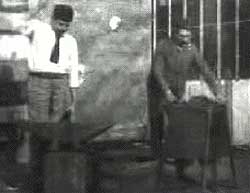 Vastly more typical of the Lumiere Brothers' films was The Blacksmiths (Le Forgerons, 1895), an "actuality" film, a genre that captured moments of real scenes.
Vastly more typical of the Lumiere Brothers' films was The Blacksmiths (Le Forgerons, 1895), an "actuality" film, a genre that captured moments of real scenes.
We're shown three quarter minutes of a blacksmithy shop. One man pounds an iron rod on an anvil & tempers it by immersion in a wooden tub of water.
The other smithy winds a divice that looks like nothing I ever associated with blacksmith shops. A third figure enters the shot just as it comes to an end.
In America, a similar actuality had already been made as Blacksmith Scene (1893). For many more actualities by the Lumieres see the reviews of several Lumiere films.
copyright © by Paghat the Ratgirl
|
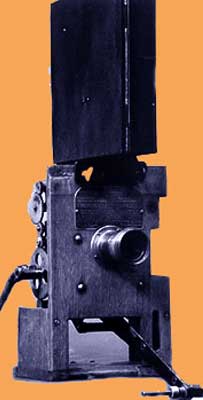




 Abadie filmed several other documentary pieces in Oklahoma, including Herding Horses Across a River (1904).
Abadie filmed several other documentary pieces in Oklahoma, including Herding Horses Across a River (1904).
